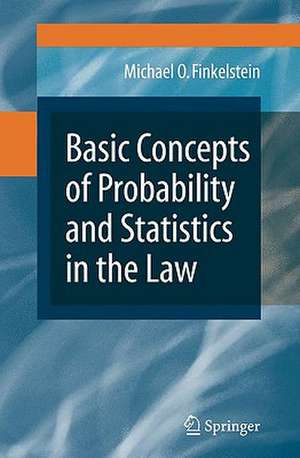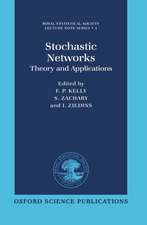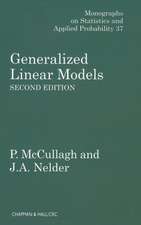Basic Concepts of Probability and Statistics in the Law
Autor Michael O. Finkelsteinen Limba Engleză Paperback – 11 iun 2009
Preț: 481.58 lei
Nou
Puncte Express: 722
Preț estimativ în valută:
92.15€ • 96.22$ • 76.09£
92.15€ • 96.22$ • 76.09£
Carte tipărită la comandă
Livrare economică 15-29 aprilie
Preluare comenzi: 021 569.72.76
Specificații
ISBN-13: 9780387875002
ISBN-10: 038787500X
Pagini: 172
Ilustrații: XII, 174 p.
Dimensiuni: 155 x 235 x 13 mm
Greutate: 0.27 kg
Ediția:2009
Editura: Springer
Colecția Springer
Locul publicării:New York, NY, United States
ISBN-10: 038787500X
Pagini: 172
Ilustrații: XII, 174 p.
Dimensiuni: 155 x 235 x 13 mm
Greutate: 0.27 kg
Ediția:2009
Editura: Springer
Colecția Springer
Locul publicării:New York, NY, United States
Public țintă
Professional/practitionerCuprins
Probability.- Descriptive Tools.- Compound Events.- Significance.- Random Variables and Their Distributions.- Confidence.- Power.- Sampling.- Epidemiology.- Combining the Evidence.- Regression Models.- Regression Models – Further Considerations.
Recenzii
From the reviews:
“…A ‘shorter and mathematically less challenging’ version of an earlier co-authored book, Statistics for Lawyers. …Full of legal argument and counter-argument forensically dissected by the author. …The book requires concentration but is fun to read. …Presents an excellent treatment of a fascinating field.” (International Statistical Review, 2010, 78, 1, 134-159)
“This work is a good introductional textbook on statistics and probability for lawyers. … The book contains … many examples (sometimes with numerical data and simple calculations) of courts decisions and discussions of real life causes. … Special attention is paid to the statistical meaning of DNA-testing procedures, analysis of epidemiologic data and discrimination causes.” (R. E. Maiboroda, Zentralblatt MATH, Vol. 1173, 2009)
“Basic Concepts of Probability and Statistics in the Law (BCPSL) is an introduction to our discipline for law students and lawyers who want to understand basic statistics and how statistics are used in legal cases. … BCPSL contains some new cases and was a fun and much faster read. … students would enjoy and learn from BCPSL. … a good choice for someone who has already had a basic statistics course or as complementary reading in an introductory course.” (Dalene Stancl, Journal of the American Statistical Association, Vol. 106 (493), March, 2011)
“The author, a lawyer by training, wrote this book as a more accessible … version of his more comprehensive book on the topic, Statistics for Lawyers (2000). This slimmer version of the more comprehensive book makes for a quick, enlightening read. While this book was written primarily for law students, it can be understood by those with formal statistical training who want to understand an area of application of statistical concepts. … statistician or student of statistics would be able to benefit from this book.” (Willis A. Jensen,Technometrics, Vol. 52 (4), November, 2010)
“…A ‘shorter and mathematically less challenging’ version of an earlier co-authored book, Statistics for Lawyers. …Full of legal argument and counter-argument forensically dissected by the author. …The book requires concentration but is fun to read. …Presents an excellent treatment of a fascinating field.” (International Statistical Review, 2010, 78, 1, 134-159)
“This work is a good introductional textbook on statistics and probability for lawyers. … The book contains … many examples (sometimes with numerical data and simple calculations) of courts decisions and discussions of real life causes. … Special attention is paid to the statistical meaning of DNA-testing procedures, analysis of epidemiologic data and discrimination causes.” (R. E. Maiboroda, Zentralblatt MATH, Vol. 1173, 2009)
“Basic Concepts of Probability and Statistics in the Law (BCPSL) is an introduction to our discipline for law students and lawyers who want to understand basic statistics and how statistics are used in legal cases. … BCPSL contains some new cases and was a fun and much faster read. … students would enjoy and learn from BCPSL. … a good choice for someone who has already had a basic statistics course or as complementary reading in an introductory course.” (Dalene Stancl, Journal of the American Statistical Association, Vol. 106 (493), March, 2011)
“The author, a lawyer by training, wrote this book as a more accessible … version of his more comprehensive book on the topic, Statistics for Lawyers (2000). This slimmer version of the more comprehensive book makes for a quick, enlightening read. While this book was written primarily for law students, it can be understood by those with formal statistical training who want to understand an area of application of statistical concepts. … statistician or student of statistics would be able to benefit from this book.” (Willis A. Jensen,Technometrics, Vol. 52 (4), November, 2010)
Textul de pe ultima copertă
This book sets out basic statistical tools as they have been applied in actual legal disputes. Examples range over diverse fields of law, such as identification evidence, mass torts, securities law, environmental regulation, and capital punishment, among many others. In some notable cases, such as the U.S. Supreme Court’s decision in Bush v. Gore, the book explores aspects of the statistical evidence that were unrecognized or misconceived by the parties or the court. For the statistics student, the book will give a deeper appreciation of foundation concepts and provide a wealth of real life applications. For the lawyer, or law student, the book will introduce a subject that has become increasingly important both in litigation and in studies of the legal system. The book is self-contained and may be read without background in probability or statistics.
Michael O. Finkelstein is a lawyer and has been described as a pioneer in the use of statistics in law. He has for many years taught Statistics for Lawyers at Columbia Law School, and has also taught this subject at Harvard, Yale, and the University of Pennsylvania law schools. In addition to numerous articles, he is the author of Quantitative Methods in Law, published in 1978, and is the co-author with Professor Bruce Levin of Statistics for Lawyers, first published in 1990 and now in its second edition.
Michael O. Finkelstein is a lawyer and has been described as a pioneer in the use of statistics in law. He has for many years taught Statistics for Lawyers at Columbia Law School, and has also taught this subject at Harvard, Yale, and the University of Pennsylvania law schools. In addition to numerous articles, he is the author of Quantitative Methods in Law, published in 1978, and is the co-author with Professor Bruce Levin of Statistics for Lawyers, first published in 1990 and now in its second edition.
Caracteristici
Provides a basic introduction to concepts of probability and statistics specifically for lawyers












